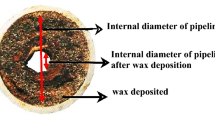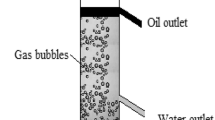Abstract
Present study deals with the development of novel biodegradable polymer device for petroleum fraction removal from different petroleum-saline emulsion. Soy protein fiber was graft copolymerized with poly(methylmethacrylate) using sequential experimental design approach. Six process variables, such as solvent amount, monomer concentration, FAS:KPS ratio, reaction time, reaction temperature, and pH were taken at two levels as per Resolution-V design. Significant process variables were monomer concentration, reaction temperature, and pH. In phase-2, screened variables were taken for model building and optimization as per optimal response surface design. At optimum conditions (monomer concentration: 3.10 mmol L−1; reaction temperature: 84.2 °C; pH 6.03), the graft percentage was found to be 272 %. Graft copolymer was characterized using FTIR, SEM, TGA, DTA, and DTG techniques. Further, graft copolymer was evaluated for acid–base and moisture resistance behavior. The synthesized soy protein fiber based polymer showed 76–70 % petroleum fraction absorption from different petroleum-saline emulsions.






Similar content being viewed by others
References
Mohanty AK, Misra M, Hinrichsen G (2000) Biofibres, biodegradable polymers and biocomposites: an overview. Macromol Mater Eng 276(277):1–24
Schilling CH, Tomasik P, Karpovich DS, Hart B, Garcha J, Boettcher PT (2005) Preliminary studies on converting agricultural waste into biodegradable plastics—part IV: polysaccharide containing natural materials. J Polym Environ 13:203–211
Pillai CKS, Paul W, Sharma CP (2009) Chitin and chitosan polymers: chemistry, solubility and fiber formation. Prog Polym Sci 34:641–678
Raafat AI, Eid M (2012) Radiation synthesis of superabsorbent CMC-based hydrogels for agriculture applications. Nucl Instrum Methods Phys Res B 283:71–76
D’Melo DJ, Shenoy MA (2008) Evaluation of mechanical properties of acrylated guar gum unsaturated polyester composites. Polym Bull 61:235–246
John M, Thomas S (2008) Biofibres and biocomposites. Carbohydr Polym 71:343–364
Chen H, Yuan L, Song W, Wu Z, Li D (2008) Biocompatible polymer materials: role of protein–surface interactions. Prog Polym Sci 33:1059–1087
Liu X, Ning J, Clark S (2009) Changes in structure and functional properties of whey proteins induced by high hydrostatic pressure: a review Front. Chem Eng China 3:436–442
Dong Q, Gu L (2002) Synthesis of AN-g-casein copolymer in concentrated aqueous solution of sodium thiocyanate and AN-g-casein fiber’s structure and property. Eur Polym J 38:511–519
Altman GH, Diaz F, Jakuba C, Calabro T, Horan RL, Chen J, Lu H, Richmond J, Kaplan DL (2003) Silk-based biomaterials. Biomater 24:401–416
Wang Y, Wang W, Shi X, Wang A (2013) Enhanced swelling and responsive properties of an alginate-based superabsorbent hydrogel by sodium p-styrenesulfonate and attapulgite nanorods. Polym Bull 70:1181–1193
Rising A, Widhe M, Johansson J, Hedhammar M (2011) Spider silk proteins: recent advances in recombinant production, structure-function relationships and biomedical applications. Cel Mole Life Sci 68:169–184
Ji J, Li B, Zong WH (2012) An Ultraelastic Poly(ethylene oxide)/Soy Protein Film with Fully Amorphous Structure. Macromol 45:602–606
Hsu S-T, Pan T-C (2007) Adsorption of paraquat using methacrylic acid-modified rice husk. Bioresour Technol 98:3617–3621
Carvalho J, Gonçalves C (2007) Production and characterization of a new dextrin-based hydrogel. Eur Polym J 43:3050–3059
Bhattacharya A, Misra BN (2004) Grafting: a versatile means to modify polymers techniques, factors and applications. Prog Polym Sci 29:767–814
Kalayci OA, Cömert FB, Hazer B, Atalay T, Cavicchi KA, Cakmak M (2010) Synthesis, characterization, and antibacterial activity of metal nanoparticles embedded into amphiphilic comb-type graft copolymers. Polym Bull 65:215–226
Sun T, Xu P (2003) Graft copolymerization of methacrylic acid onto carboxymethyl chitosan. Eur Polym J 39:189–192
Mohanty N, Pradhan B, Mohanta MC, Das HK (1983) Grafting vinyl monomers on silk fibres-I. Eur Polym J 19:415–418
George A, Radhakrishnan G, Joseph KT (1985) Grafting of butyl acrylate onto gelatin in a water-isopropanol medium. Polym 26:2064–2068
Sun T, Xu P (2003) Graft copolymerization of methacrylic acid onto carboxymethyl chitosan. Eur Polym J 39:189–192
Mattil KF (1974) Composition, nutritional, and functional properties, and quality criteria of soy protein concentrates and soy protein isolates. J Am Oil Chem Soc 51:81A–84A
Zhang YI, Ghasemzadeh S, Kotliar AM, Kumar S, Presnell S, Williams LD (1999) Fibers from soybean protein and poly (vinyl alcohol). J Appl Polym Sci 71:11–19
Vynias, D (2006) An investigation into the wet processing and surface analysis of soybean fabrics, PhD Thesis, The University of Manchester, UK
Vynias D (2011) Soybean fibre: a novel fibre in the textile industry. In: Ng TB (ed) Soybean—biochemistry, chemistry and physiology. InTech, Croatia, pp 461–493
Swain SN, Rao KK, Nayak PL (2005) Thermal degradation of biodegradable plastics cross-linked from formaldehyde-soy protein concentrate. J Thermal Anal Calorim 79:33–38
Nanda PK, Rao KK, Nayak PL (2007) Biodegradable polymers XI spectral, thermal, morphological, and biodegradability properties of environment-friendly green plastics of soy protein-modified with thiosemicarbazide. J Appl Polym Sci 103:3134–3142
Author information
Authors and Affiliations
Corresponding author
Electronic supplementary material
Below is the link to the electronic supplementary material.
Rights and permissions
About this article
Cite this article
Kaith, B.S., Bhatia, J.K., Dhiman, J. et al. Synthesis and optimization of soy protein fiber based graft copolymer through response surface methodology for removal of oil spillage. Polym. Bull. 70, 3155–3169 (2013). https://doi.org/10.1007/s00289-013-1014-0
Received:
Revised:
Accepted:
Published:
Issue Date:
DOI: https://doi.org/10.1007/s00289-013-1014-0




